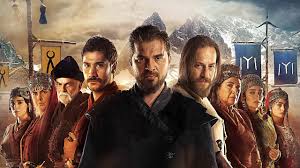Dirtilis Ertugrul

Dirilis Erugrul With English Subtitles
“Diriliş: Ertuğrul,” known internationally as “Resurrection: Ertugrul,” is a Turkish historical fiction television series that captivated audiences across the globe with its rich narrative, dynamic characters, and immersive depiction of the 13th-century Anatolian landscape. The series, which aired from 2014 to 2019, spans five seasons and chronicles the life and struggles of Ertuğrul Bey, the father of Osman I, the founder of the Ottoman Empire. Created by Mehmet Bozdağ, “Diriliş: Ertuğrul” is more than just a TV show; it is a cultural phenomenon that explores themes of faith, honor, justice, and the eternal struggle between good and evil.
The Historical Context
Set in the 13th century, “Diriliş: Ertuğrul” takes place during a tumultuous period in Anatolia, a region divided between various Turkic tribes, the Byzantine Empire, and the remnants of the Seljuk Empire. The Mongol invasions from the east added to the chaos, creating a power vacuum that different factions sought to fill. The series begins with Ertuğrul Bey, the leader of the Kayı tribe, a small but resilient nomadic group, who dreams of finding a permanent homeland for his people.
Ertuğrul, portrayed by Engin Altan Düzyatan, is depicted as a visionary leader with unwavering faith in his mission. Throughout the series, he faces numerous challenges from both external enemies and internal betrayal. The show meticulously weaves historical facts with fictional elements, creating a narrative that not only entertains but also educates its audience about a critical period in Turkish and Islamic history.
The Rise of Ertuğrul Bey
Ertuğrul’s journey begins with his tribe in search of a safe place to settle. The Kayı tribe, weary from years of wandering and warfare, is on the brink of despair when Ertuğrul takes charge. His leadership is marked by his strong moral compass, his devotion to justice, and his ability to inspire those around him.
One of the central conflicts in the early seasons is the tribe’s struggle against the Knights Templar, a powerful and secretive organization determined to crush the Muslim presence in the region. The Templars, led by the cunning and ruthless Petruccio Manzini, pose a significant threat to Ertuğrul and his people. The series portrays the Templars as not just a physical adversary but as a symbol of the larger clash between civilizations, where Ertuğrul represents the values of Islam and the pursuit of justice.
As the series progresses, Ertuğrul’s leadership and strategic brilliance allow him to forge alliances, outmaneuver his enemies, and expand his influence. His marriage to Halime Sultan, portrayed by Esra Bilgiç, further strengthens his resolve. Halime is not just a supportive partner but also a key figure in the series, embodying the virtues of loyalty, wisdom, and courage. Their relationship is a central pillar of the narrative, showcasing a partnership built on mutual respect and shared ideals.
Themes of Faith and Justice
One of the most compelling aspects of “Diriliş: Ertuğrul” is its exploration of faith. The series frequently highlights the importance of Islamic principles in guiding Ertuğrul’s actions and decisions. His reliance on prayer, his adherence to the teachings of the Quran, and his commitment to the concept of adâlet (justice) resonate deeply with viewers, especially those who see in Ertuğrul a reflection of their own values.
Ertuğrul’s faith is not portrayed as a passive element of his character but as a driving force that compels him to fight against oppression and injustice. His belief in a just cause is what motivates him to confront seemingly insurmountable odds, whether facing the might of the Mongol army or dealing with treachery within his ranks.
The series also delves into the idea of ghaza (holy struggle), where the battles fought by Ertuğrul and his warriors are seen as part of a larger, divinely ordained mission. This theme resonates strongly with the concept of the ghazi, a warrior for Islam, which is central to the identity of Ertuğrul and later, the Ottoman sultans.
The Cultural Impact
“Diriliş: Ertuğrul” has had a profound cultural impact, not just in Turkey but globally. The series has been dubbed or subtitled into numerous languages, reaching audiences in the Middle East, South Asia, Africa, and even parts of Europe and North America. Its popularity in Pakistan, for example, has led to a cultural exchange where Turkish culture and Islamic history are celebrated and embraced. The series has also inspired a resurgence of interest in Ottoman history and Islamic heritage, with viewers eager to learn more about the era that shaped one of the most powerful empires in history.
The portrayal of Ertuğrul as a heroic and devout leader has resonated with many who see in him a role model for leadership based on principles rather than power. His unwavering commitment to justice and his ability to navigate complex political landscapes have made him a figure of admiration and inspiration.
Visual Storytelling and Production Value
The success of “Diriliş: Ertuğrul” is also due to its high production values. The series is known for its epic battle scenes, intricate costume design, and stunning cinematography that captures the rugged beauty of the Anatolian landscape. The attention to historical detail in the set design, weaponry, and attire helps transport the audience back in time, creating an immersive viewing experience.
The use of traditional music, composed by Alpay Göltekin and Zeynep Alasya, adds to the authenticity and emotional depth of the series. The music, which blends Turkish folk melodies with epic orchestral compositions, has become iconic in its own right, further enhancing the series’ appeal.
Legacy and Continuation
Following the success of “Diriliş: Ertuğrul,” the story of the Ottoman Empire’s origins continues with the sequel series “Kuruluş: Osman,” which focuses on Ertuğrul’s son, Osman I, and the establishment of the Ottoman Empire. The legacy of “Diriliş: Ertuğrul” lives on in this continuation, as well as in the hearts of its global fanbase.
The series has also sparked a renewed interest in the values and traditions depicted in the show, leading to discussions about the relevance of these principles in the modern world. Ertuğrul’s emphasis on justice, unity, and faith provides a counter-narrative to the often fragmented and polarized world of today.
Conclusion
“Diriliş: Ertuğrul” is more than just a television series; it is a cultural phenomenon that has captured the imagination of millions. Through its compelling narrative, rich historical context, and portrayal of timeless values, it offers a window into a pivotal era in history and a reflection of the universal struggle for justice and righteousness. As viewers follow the journey of Ertuğrul Bey, they are not only entertained but also inspired to reflect on their own lives and the principles that guide them. The series stands as a testament to the power of storytelling in bridging cultures, igniting passions, and fostering a deeper understanding of our shared human heritage.
